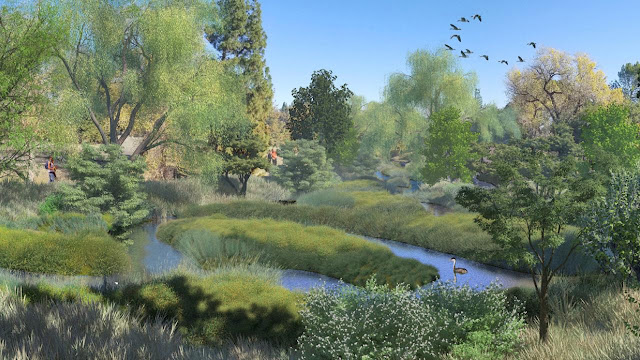
$5.4 million grant allows for project's completion

|
| This artist's rendering shows what the Arboretum Waterway project will look like when completed. (Courtesy UC Davis Arboretum) |
A long-awaited transformation at UC Davis is a step closer to reality – the completion of the Arboretum Waterway habitat project.
The university has received a $5.4 million grant from the California Natural Resources Agency to finish the “Arboretum Waterway Flood Protection and Habitat Enhancement” project. The public is invited to a virtual community meeting via Zoom to discuss the project at 7 p.m Thursday, Feb. 24. Advance registration for the meeting is required; sign up here: https://bit.ly/3uBcST1
Phase 1 of the project was completed in 2018. That phase engineered water flow and replanted native vegetation near the arboretum’s Wyatt Deck, through the Redwood Grove to the eastern end of the Arboretum Waterway.
Four years later, the arboretum can now tackle the remaining three phases of the waterway’s makeover, starting at Lake Spafford (near Mrak Hall) and extending west to the campus equestrian center. Besides the new grant, the university will contribute $2.5 million in deferred maintenance funds to the waterway project.
“We are ecstatic about this project,” said Kathleen Socolofsky, assistant vice chancellor and director of the Arboretum and Public Garden, in an official release. “It has all come together thanks to many thoughtful years of planning and collaboration with faculty and other campus partners. The proof of concept for our overall plan is flourishing and now we can finish the transformation.”
Also known as Putah Creek (although it doesn’t actually connect to that creek), the Arboretum Waterway forms the backbone of the arboretum as well as serves as part of the campus flood control system.
Expected to be completed in 2024, the remaining phases will remove concrete walls that now line the waterway and replace them with gently sloped earthen banks studded with trees, shrubs and native plants. As a home to birds and other wildlife, the waterway will be reshaped with islands in the stream, narrows to speed water flow and pockets of marshlike wetlands.
In addition to helping wildlife, the project will also greatly benefit students – especially those studying wetland habitat restoration – by providing hands-on job training. Working with the arboretum in the restoration project will be the California Conservation Corps and the Center for Land-Based Learning’s SLEWS (Student and Landowner Education and Watershed Stewardship) program.
Learn more at https://arboretum.ucdavis.edu .
Comments
0 comments have been posted.Sacramento Digs Gardening to your inbox.
Food in My Back Yard Series
May 6: Maintain soil moisture with mulch for garden success
April 29: What's (already) wrong with my tomato plants?
April 22: Should you stock up on fertilizer? (Yes!)
April 15: Grow culinary herbs in containers
April 8: When to plant summer vegetables
April 1: Don't be fooled by these garden myths
March 25: Fertilizer tips: How to 'feed' your vegetables for healthy growth
March 18: Time to give vegetable seedlings some more space
March 11: Ways to win the fight against weeds
March 4: Potatoes from the garden
Feb. 25: Plant a fruit tree now -- for later
Feb. 18: How to squeeze more food into less space
Feb. 11: When to plant? Consider staggering your transplants
Feb. 4: Starting in seed starting
Sites We Like
Garden Checklist for week of May 4
Enjoy this spring weather – and get gardening!
* Plant, plant, plant! It’s prime planting season in the Sacramento area. Time to set out those tomato transplants along with peppers and eggplants. Pinch off any flowers on new transplants to make them concentrate on establishing roots instead of setting premature fruit.
* Direct-seed melons, cucumbers, summer squash, corn, radishes, pumpkins and annual herbs such as basil.
* Harvest cabbage, lettuce, peas and green onions.
* In the flower garden, direct-seed sunflowers, cosmos, salvia, zinnias, marigolds, celosia and asters. (You also can transplant seedlings for many of the same flowers.)
* Plant dahlia tubers. Other perennials to set out include verbena, coreopsis, coneflower and astilbe.
* Transplant petunias, marigolds and perennial flowers such as astilbe, columbine, coneflowers, coreopsis, dahlias, rudbeckia and verbena.
* Keep an eye out for slugs, snails, earwigs and aphids that want to dine on tender new growth.
* Feed summer bloomers with a balanced fertilizer.
* For continued bloom, cut off spent flowers on roses as well as other flowering plants.
* Add mulch to the garden to maintain moisture. Mulch also cuts down on weeds. But don’t let it mound around the stems or trunks of trees or shrubs. Leave about a 6-inch to 1-foot circle to avoid crown rot or other problems.